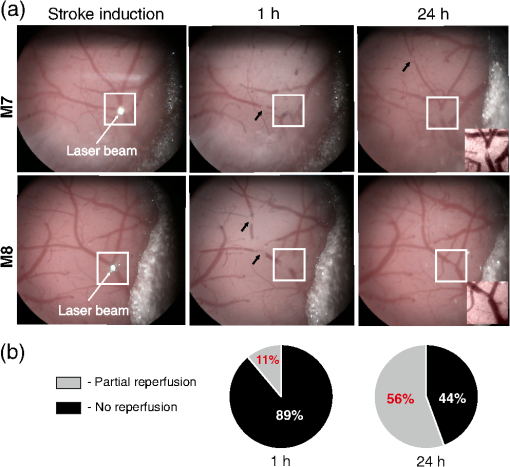In vivo brain imaging with multimodal optical coherence microscopy in a mouse model of thromboembolic photochemical stroke
Neurophotonics 2020 | 7(1), 015002
Hubert Dolezyczek, Szymon Tamborski, Piotr Majka, Danuta M. Sampson, Maciej Wojtkowski, Grzegorz Wilczynski, Maciej Szkulmowski, Monika Malinowska
Abstract:
We used a new multimodal imaging system that combines optical coherence microscopy and brightfield microscopy. Using this in vivo brain monitoring approach and cranial window implantation, we three-dimensionally visualized the vascular network during thrombosis, with high temporal (18 s) and spatial (axial, 2.5 μm; lateral, 2.2 μm) resolution. We used a modified mouse model of photochemical thromboembolic stroke in order to more accurately parallel human stroke. Specifically, we applied green laser illumination to focally occlude a branch of the middle cerebral artery. Despite the recanalization of the superficial arteries at 24 h after stroke, no blood flow was detected in the small vessels within deeper regions. Moreover, after 24 h of stroke progression, scattering signal enhancement was observed within the stroke region. We also evaluated the infarct extent and shape histologically. In summary, we present a novel approach for real-time mouse brain monitoring and ischemic variability analysis. This multimodal imaging method permits the analysis of thrombosis progression and reperfusion. Additionally and importantly, the system could be used to study the effect of poststroke drug treatments on blood flow in small arteries and capillaries of the brain.
Figure: Reperfusion of MCA branches within the stroke induction region. (a) Brightfield microscope images showing the brain surface in two representative mice (M7 and M8) during stroke photoinduction and at 1 and 24 h postinduction. White squares indicate the regions, in which the laser beam was focused on the MCA bifurcation. Black arrows show clot positions in the vessel lumen. Insets show magnifications of the occluded MCA without reperfusion (M7) and with partial reperfusion (M8) at 24 h after stroke photoinduction. (b) Percentage of mice with partial or no reperfusion ().



